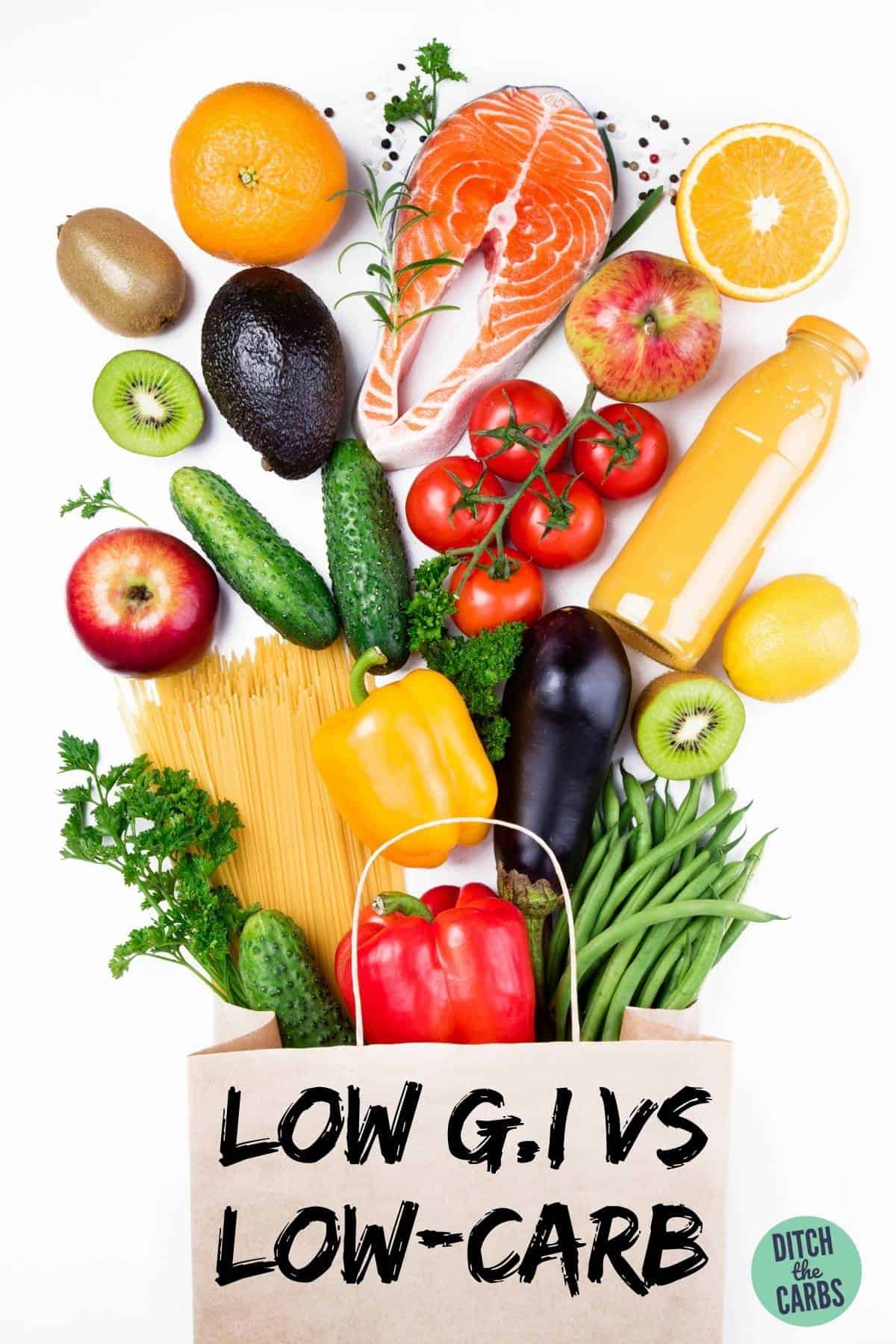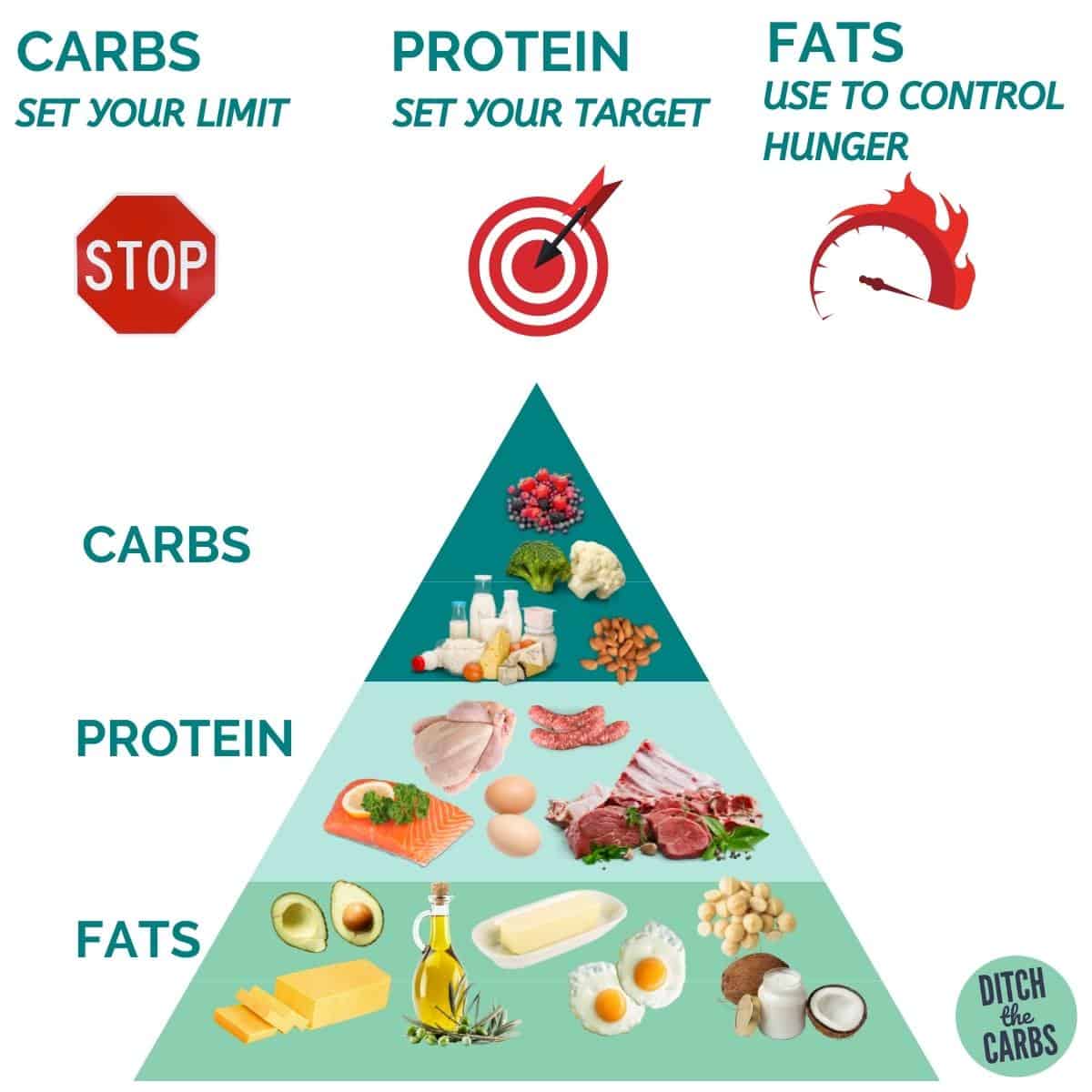Using the glycemic index (GI) can be confusing. Is a low GI diet the same as a low-sugar diet or a low-carb diet?
This article will help you understand what the difference is between a low GI, high GI, and what GI values mean in general. And which is better for weight loss? A low GI diet or a low-carb diet?

What is a glycemic index?
The Glycaemic Index (GI) is a scale of how fast sugars, starches, and carbohydrates are absorbed in the body from a scale of 0 – 100 (100 being the rate of pure glucose).
What is the GI of food? There are 3 categories of GI values of food:
Are you ready to lose weight and heal your body for life (without dieting, drugs, or making yourself miserable)?

Our free on-demand video training will walk you through how to make this THE year you set health goals…and keep them.
- low GI (less than 55)
- medium GI (55-69)
- high GI (70-100)
Knowing the glycemic index of foods is a useful tool. However, do not make the mistake of thinking that if a food is low in GI it is low in carbs. Often, a low GI food is misleading because it may also be high in total carbohydrates.
The glycemic index only tells you is the RATE at which foods are turned into sugars in your bloodstream. It does not reflect HOW MANY carbs are in each food. It does not tell you of the impact on blood sugars and for how long (the glycaemic load).
What are low GI foods?
Some common examples of low GI foods are below, but many are also high in total carbohydrates such as rice and chickpeas.
- Vegetables such as asparagus, broccoli, cauliflower, lettuce.
- Fruits such as grapefruit, banana, apple, peach.
- Rice, oats.
- Beans, pulses, rice, chickpeas.
What does a low glycemic index mean?
Foods with low GI values are slowly digested and slowly broken down to cause a slow gradual rise in blood sugar levels.
For example, dates have a glycemic index of 31, which would be acceptable on a low glycemic diet. However, one serving size provides 46g of carbohydrate! A Snickers® bar is considered to be a low GI food at 41.
All the GI values are telling you is that the sugars in dates are absorbed over a longer period and do not cause a sugar spike (then insulin spike) but it will raise blood sugar levels for a longer period because of the high number of grams of carbohydrate.
What are high GI foods?
Foods with a high glycemic index are those that quickly increase your blood glucose, resulting in a rapid blood glucose spike (and subsequent rapid crash).
Some examples of foods to avoid with high GI values are:
- gluten free bread 80
- white bread 89
- doughnuts 76
- watermelon 82
- cornflakes 92
- rice cakes 82
Many food manufacturers love to state they are “low glycemic index foods” and many do have low glycemic index values, but neither of these necessarily translate into low in carbs. Learn how to read food labels because modern food marketing is based on confusion.
What is glycaemic load or glycemic response?
Glycemic load is the combination of QUALITY of food (GI) and the QUANTITY of food (carb value). It’s probably a better value to rely on, although it is not a common value or easy to find.
Glycemic Load = GI (%) x Carbohydrate (grams) content per portion ÷ 100
Source: Gisymbol
Glycemic response is a reflection of how your blood sugars will respond to a certain food. How your blood sugar rises will depend on how the food was cooked (raw, boiled, over cooked), how processed the food is, whether the food is eaten with fat or protein.
Glycaemic index and carb charts
| Food | GI | Carbs |
|---|---|---|
| Chickpeas | 10 | 30 |
| Cannelloni | 15 | 54 |
| White rice | 17 | 43 |
| Barley | 22 | 42 |
| Lasagna | 20 | 48 |
| Kidney beans | 21 | 35 |
| Dates | 31 | 46 |
| Apricots | 30 | 27 |
| Snickers® bar | 41 | 36 |
| Oats | 75 | 23 |
| Pumpkin | 75 | 4 |
| Watermelon | 82 | 6 |
| Sugar | 84 | 10 |
| White bread (wheat flour) | 89 | 20 |
| Cornflakes | 92 | 26 |
| Potato (boiled) | 101 | 17 |
Source: Glycemic Index
Can low GI foods help me lose weight?
You cannot rely on the glycemic index and glycemic load to help you lose weight. A low glycemic index food will give you a slower more gradual rise in blood sugars, so that may help to stop the sugar crash that some high GI foods may give you. However, many low GI foods are also high in carbs (eg:Snickers®, chickpeas and rice) so the impact on your blood sugars will be slow and long.
You also need to look at how much fat and protein a food has to help keep you fulfilled for longer. In the long run, this is what will help you to reduce your total calorie intake and to help regulate your appetite.
Take home message: Eat lower carb, higher protein, moderate fat whole foods with minimal processing.
Low-carb keto food pyramid
Low glycemic index diets alone will not help weight loss of blood glucose levels.
Can the glycaemic index help diabetics?
Eating a low glycemic index diet can help those with diabetes get better blood glucose levels but you also need to reduce the AMOUNT of carbohydrates you eat.
Low-carb (quantity) and whole food (quality) is is more important than low GI.
It is more useful to look at the low-carb and keto food pyramid than to use the glycemic index. Learn how to eat for diabetes so you can avoid the serious complications of chronic high blood sugars.

Conclusion: Low GI vs low-carb
The glycemic index is only a reflection of the RATE of conversion and rise of blood sugars. Low-carb foods let you know the QUANTITY of carbohydrates in food.
For optimal health, stable and normal blood sugars, and weight loss, base your meals on a healthy diet of lower carb, high protein, moderate fat whole foods that have minimal processing.

What if you could actually take control of
your health in just 10 days?
It’s not your fault you can’t lose weight as a woman over 40 even though you’ve likely tried literally everything. Your metabolism probably feels broken and your hormones are likely all out of whack.
But you can fix it all with ONE simple change: eliminate sugar. We make it super easy with daily lessons teaching you the science behind what makes us gain weight in our midlife and beyond! Are you ready to get started now?












0 Comments